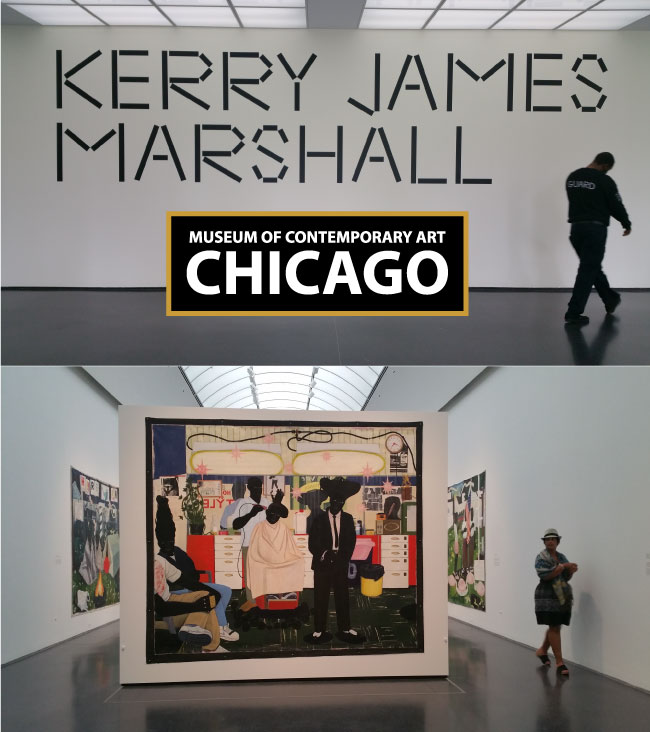
Spontaneous Saturday afternoons are the best, aren’t they?
During the summer I visited a friend (and fellow art lover) in Chicago and on a whim we decided to go to the Museum of Contemporary Art. We could not have picked a better time to visit! We had the chance to catch the Mastry Exhibition showcasing the breathtaking work of Kerry James Marshall.
THE BACKGROUND
Kerry James Marshall is an African-American artist whose work poignantly expresses the Black experience in United States and throughout the African Diaspora. Marshall was born in the unsegregated Jim Crow South and his art studies have taken him across the country from Los Angeles, where he was the apprentice of acclaimed painter Charles White, to New York City where he participated in the residency program at the Studio Museum in Harlem.
The exhibition’s title (Mastry) is not only a nod to Marshall’s mastery of a wide range of artistic techniques, but also to the intricacies of the slave/master relationship that form one of the darkest cornerstones of American history. Kerry James Marshall has a powerful artistic voice, and he is best known for his large scale paintings (you can see the scale of his work in the picture above). The color Black plays a prominent role in his paintings – he uses it in a manner that is as complex and diverse as the “Black People” it represents.
THE PAINTINGS
Following are a few photographs I took while visiting the exhibition. The captions are adapted from content provided by the Museum of Contemporary Art Chicago.
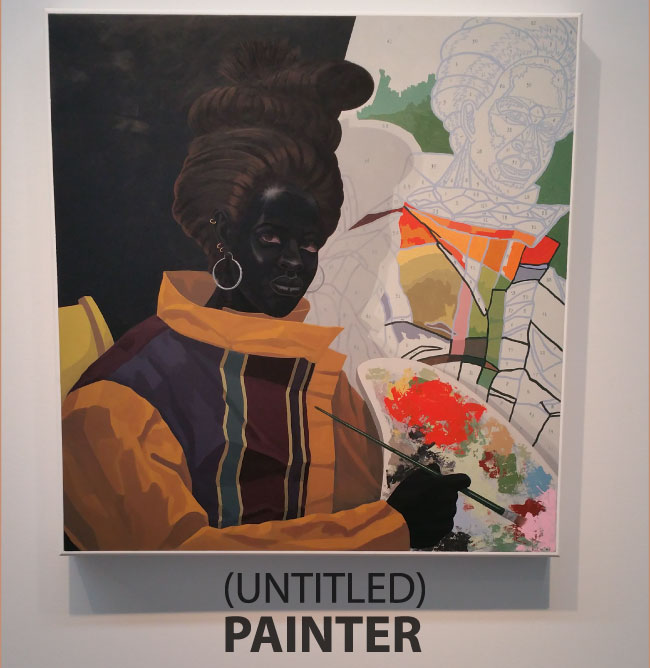
Untitled (Painter), 2010 Acrylic on PVC panel
The painter in this piece is working on paint-by- number set. At first this might seem to belittle her as a hobbyist, but the paint-by-number system enables anyone to paint—even those who never thought they had the ability to make art. By not following the prescribed colors, these artists are also making the system their own. Paint by number is a cultural phenomenon that arose in the 1950s, alongside the stirrings of the civil rights movement. Attuned to this meaningful coincidence, Marshall conjured the presence of African American artists who are seen painting themselves into being.
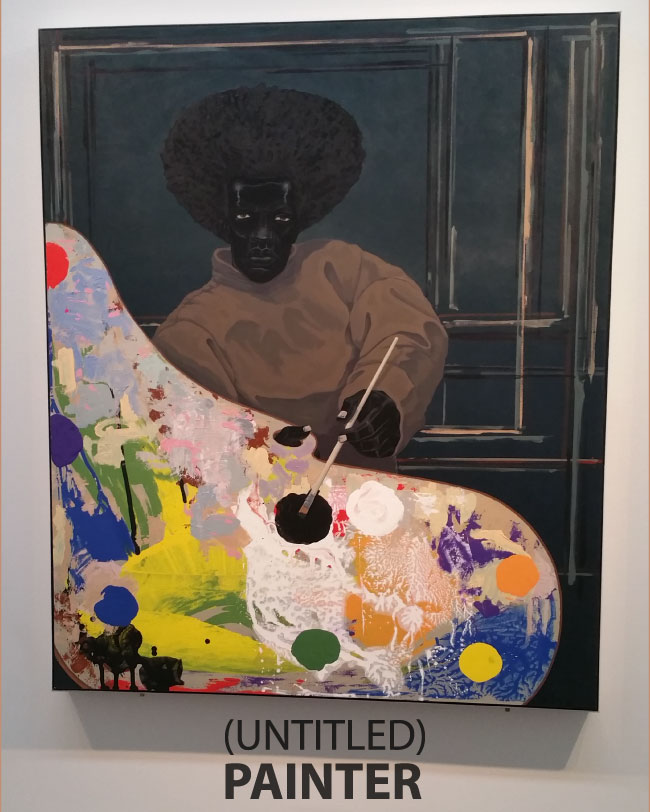
Untitled (Painter), 2010 Acrylic on PVC panel
In this painting, the African American artist holds up an oversized palette, which at a glance looks like an abstract painting in the middle of the figurative portrait. The great promise attached to modernist abstraction in the twentieth century often meant something different for artists of color. As Marshall has observed, many African American artists held “a belief that abstraction would emancipate them and their artworks from racial readings.” This notion of abstraction as a means of achieving artistic freedom shadows all of the painters in Marshall’s series. At the same time, his very choice to depict them embodies an inverse belief—foundational to his work—in the vital importance of populating museums with Black figures.
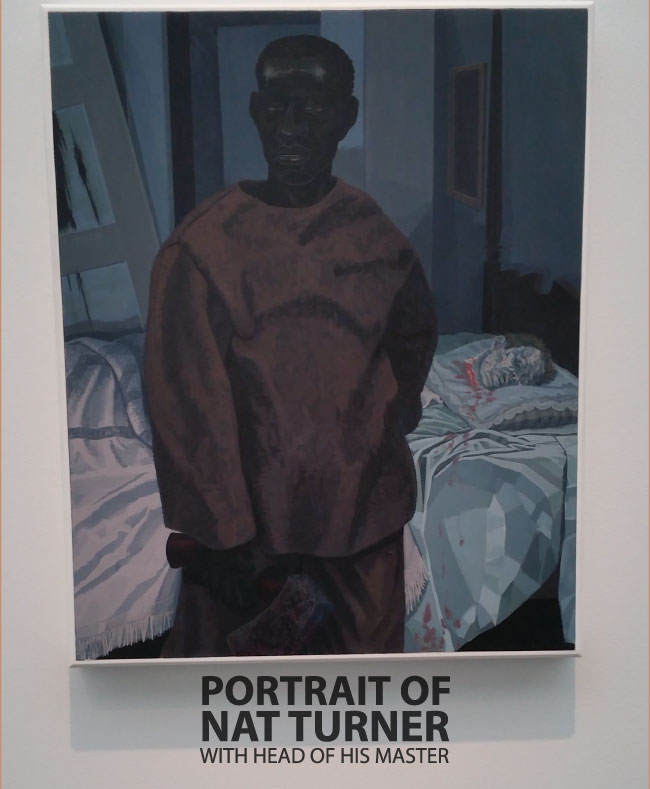
Portrait of Nat Turner with the Head of His Master, 2011 Oil on canvas
This portrait is part of a series of paintings depicting historical black figures. Nat Turner led an 1831 slave rebellion in Virginia that resulted in the deaths of sixty people, including his white owner. Turner defiantly confronts the viewer head-on, nonchalantly holding a bloodied axe, with the severed head of his former master on the pillow behind him. Marshall’s painting recalls Renaissance and Baroque depictions of heroicized biblical decapitations, such as David with the head of Goliath or Judith with the head of Holofernes.
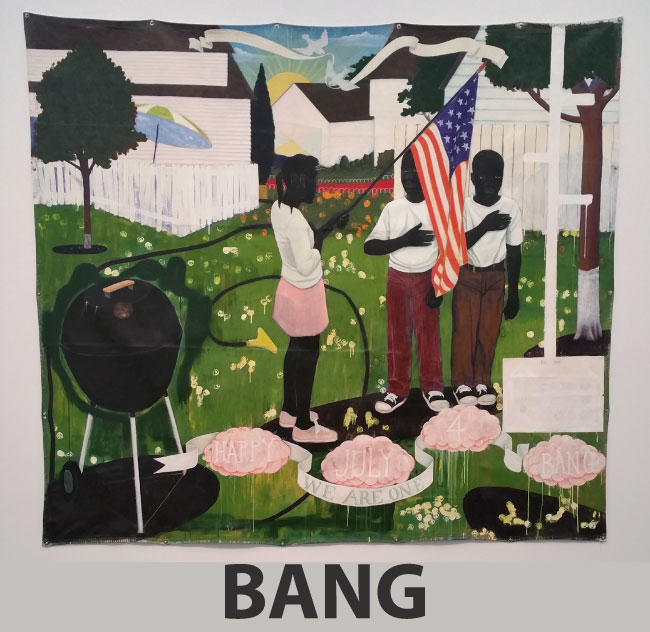
Bang, 1994 Acrylic and oil on unstretched canvas
Bang depicts three African American children standing in a backyard as the sun sets over a residential neighborhood, complete with picket fences. An idealized scene of the Fourth of the July, it questions who is fully included in the life of the nation and who benefits from its greatest ideals. The banner near the bottom of the painting evokes the proposed unity at the heart of American democracy. And yet the banner in the sky, held by doves, introduces a measure of doubt: the slogan “Resistance to Tyranny is Obedience to God” may recall the defiance of the original American colonists, but both tyranny and resistance might have different faces today.
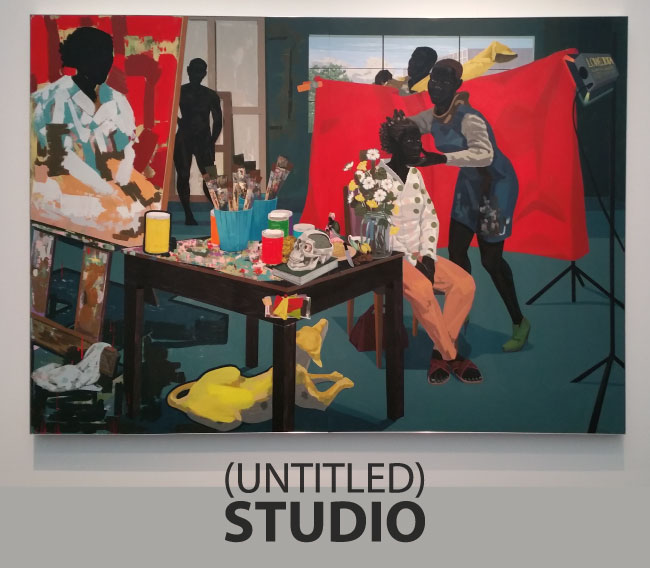
Untitled (Studio), 2014 Acrylic on PVC panel
In this painting, Marshall continued the tradition of artists painting their studios or themselves at work, in particular referencing classic examples by Diego Velazquez, Las Meninas (1656) and Gustave Courbet, The Painter’s Studio (1855). With models posing and traces of the painter’s work— paintbrushes, lighting, stacked canvases—throughout the image, evidence of the artist’s presence remains. Yet Marshall’s tableau appears to be missing an artist. In portraying the studio, the artist not only depicted the site of art production but also the place where art history can be written—and revised.
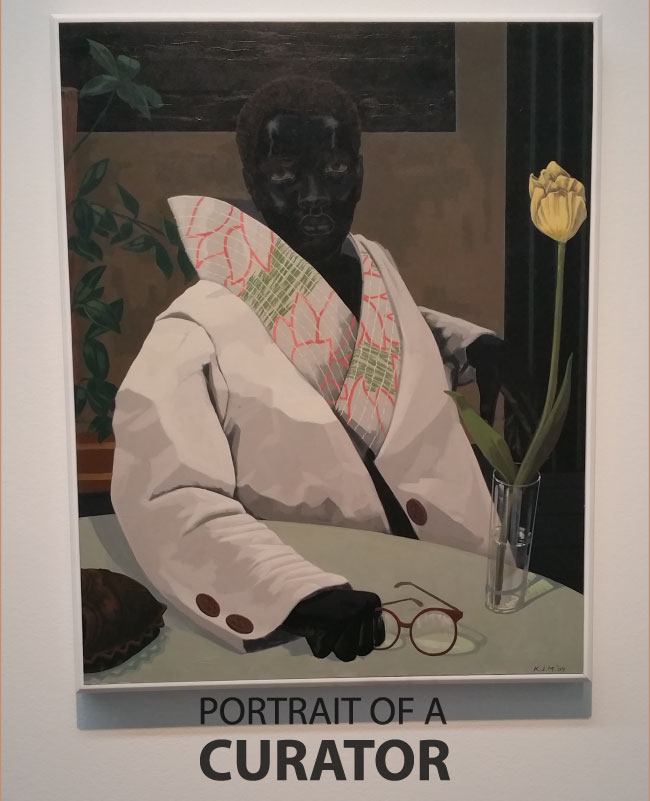
Portrait of a Curator (In Memory of Beryl Wright), 2009 Acrylic on PVC panel
Marshall’s Portrait of a Curator (In Memory of Beryl Wright) presents an elegant woman with a strong gaze, seated casually beside a yellow tulip. This work diverges from his other paintings of real people, in part because it depicts a contemporary figure rather than someone from the more distant past. Marshall dedicated this portrait to Beryl Wright, a pioneering African American curator who worked at the MCA from 1991 to 1994 and advocated for black artists during her career before ending her own life in 2000.
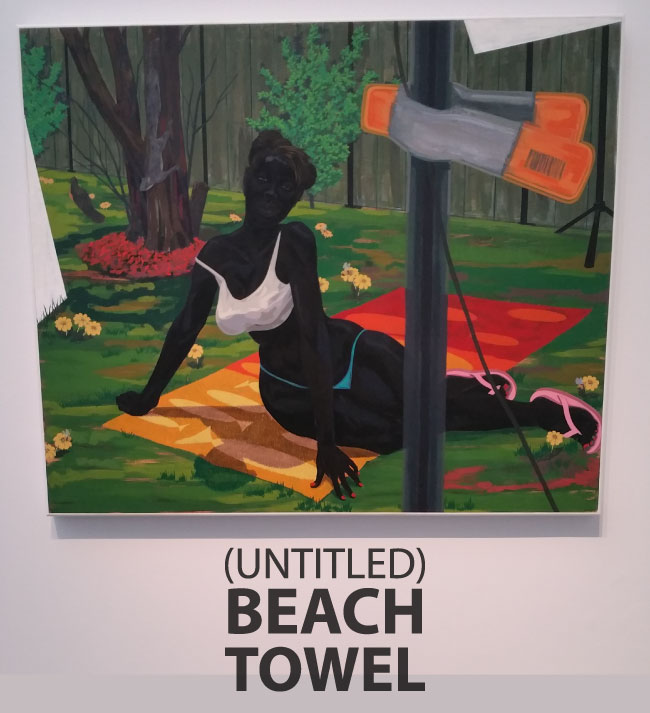
Untitled (Beach Towel), 2014 Acrylic on PVC panel
In this painting, the reclining woman appears to be the subject of a photo shoot—the pole and orange clamp in the foreground suggest a setup for lighting. As Marshall has explained, she is actively participating in how she is portrayed, presenting herself to the photographer to be made into an image of desire. In this and other recent paintings, Marshall has chosen to depict mundane scenes. These subjects reaffirm the normalcy of black lives and even find glamour in the ordinary. The challenge, in his view, is to make it so that images like this become unexceptional— subjects you can expect to see in museums and everywhere else.
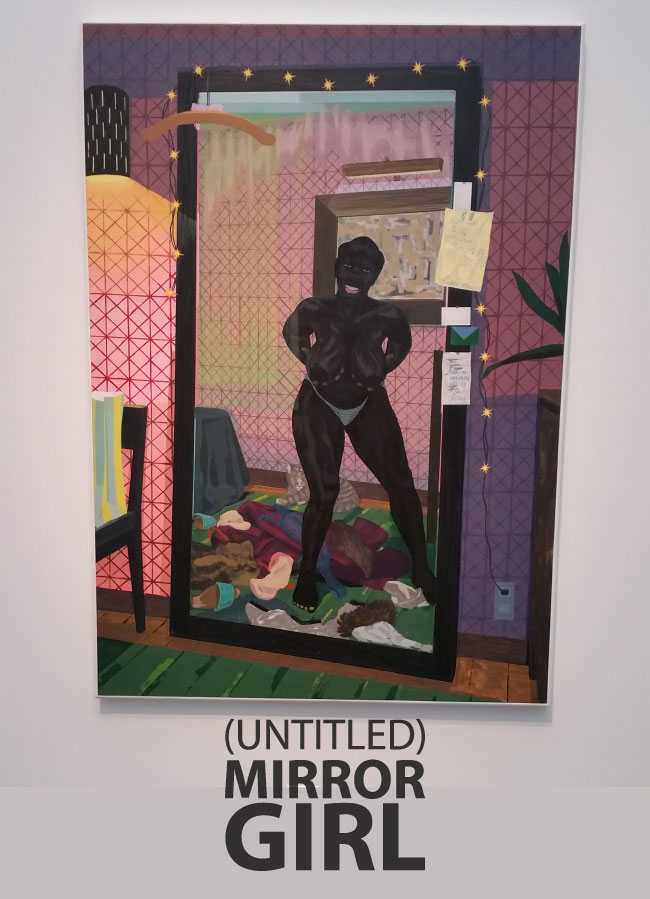
Untitled (Mirror Girl), 2014 Acrylic on PVC panel
As Marshall has observed, images of the black body as traumatized are common, but it’s rare to see representations of black people as self-satisfied individuals. In this painting, that’s exactly what is shown: a woman stands in front of her bedroom mirror, confident and pleased—she’s not posing for anyone but herself. This work, like others in this gallery, represents a black subject involved in creating her own image, an image associated with beauty, desire, or joy. In doing so, Marshall has also drawn attention to the act of looking, setting up a complicated negotiation in the painting between the subject, the viewer, and the artist himself.
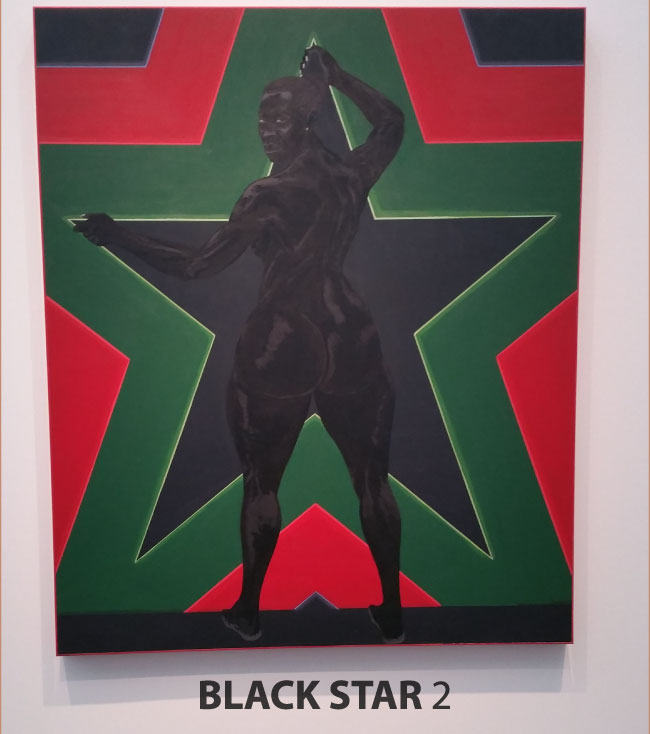
Black Star 2, 2012 Acrylic on PVC panel
Marshall titled this work after the Black Star Line, a shipping company established by the political visionary Marcus Garvey, founder of the Universal Negro Improvement Association, in 1919 to transport people back to Africa and promote trade of African goods. Ships sailing under the Black Star Line flag later became potent symbols of the Back-to-Africa movement. The geometrical patterning references mid-twentieth-century art history, in particular Frank Stella’s black-and-white paintings. The female figure asserts herself, however, as the painting’s real star, in this confident, defiant celebration of black beauty.
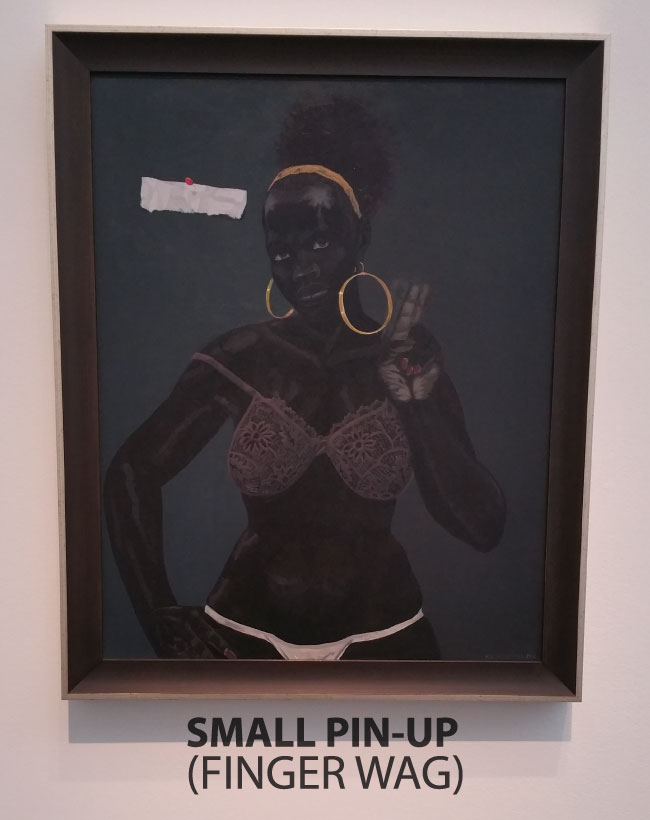
Small Pin-Up (Fingerwag), 2013 Acrylic on PVC panel
In this painting, Marshall wags a finger at the racial bias of pop culture, one that privileges white standards of beauty. The figure, although titled after the typical pin-up model, does not wear the conventional lingerie or assume the smiling pose of a seductress. Her confident gaze and admonishing gesture establishes her as a subject who refuses to be objectified.
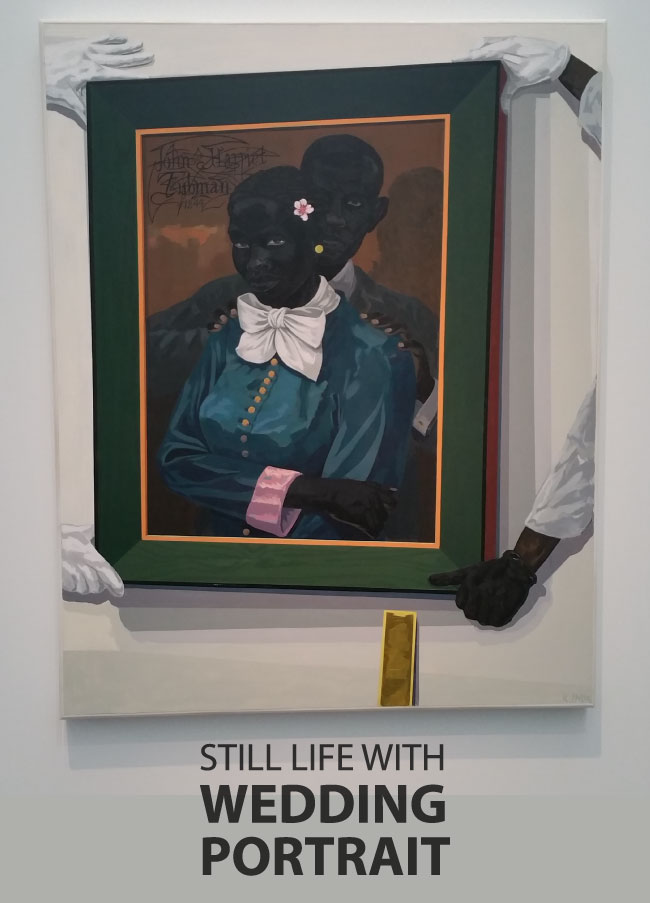
Still Life with Wedding Portrait, 2015 Acrylic on PVC panel
Marshall imagined a wedding portrait of a young Harriet Tubman—the famous abolitionist and escaped slave—and her first husband, John. Marshall hinted at Tubman’s interior life, presenting her as someone’s beloved wife and not simply the stalwart resistance hero portrayed in standard histories. At the same time, Marshall also connected Tubman to more recent events. Four hands position the couple’s portrait on the wall: three wear the standard white gloves used for handling art, but the fourth is clad in leather, reminiscent of the black-gloved salute that the athletes Tommie Smith and John Carlos raised in protest while receiving medals at the 1968 Summer Olympics.
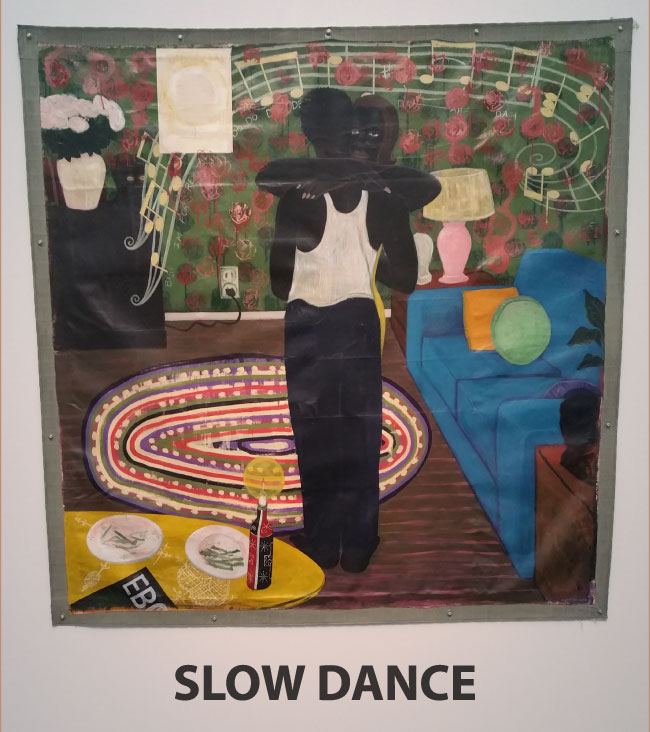
Slow Dance,1992–93 Mixed media and acrylic on unstretched canvas.
Slow Dance is one of Marshall’s first works to foreground African American domesticity and romance. In this painting, a young couple sways in the middle of a living room while the song “Baby I’m for Real” by the Originals plays on the stereo. The everyday scene includes a half-eaten dinner on the table, as well as other details that signify a rich interior life, rife with expectation and desire. At the same time, Marshall painted the rug at an odd angle, and a decorative pattern appears as wallpaper and a motif on the surface of the painting. These embellishments both introduce elements of abstraction and draw attention to the painting’s construction.
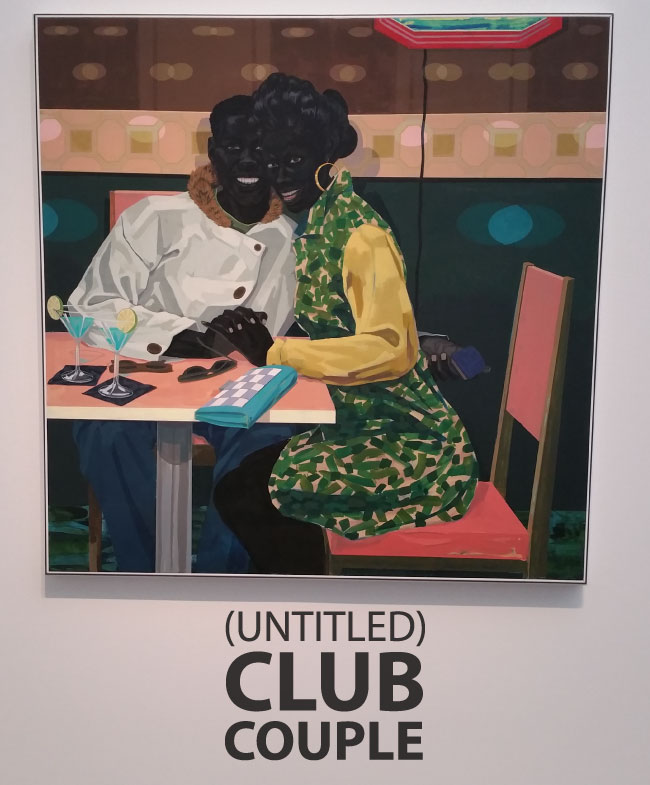
Untitled (Club Couple), 2014 Acrylic on PVC panel
Club Couple captures a moment when a young man is about to propose. The stylish couple looks out at the viewer as if smiling for a friend’s camera, as the man holds a ring box behind his companion’s back. The square format of the canvas may bring to mind an Instagram photo. This painting continues Marshall’s attention to black romance, echoing the Vignettes that appear earlier in the exhibition. Marshall is attempting to build a rich legacy of pictures depicting ordinary African Americans engaged in universal activities, both mundane moments and milestones. The paintings are beautifully, meticulously made, with complex compositions, requiring all the skills and knowledge of the medium that Marshall has developed over time.
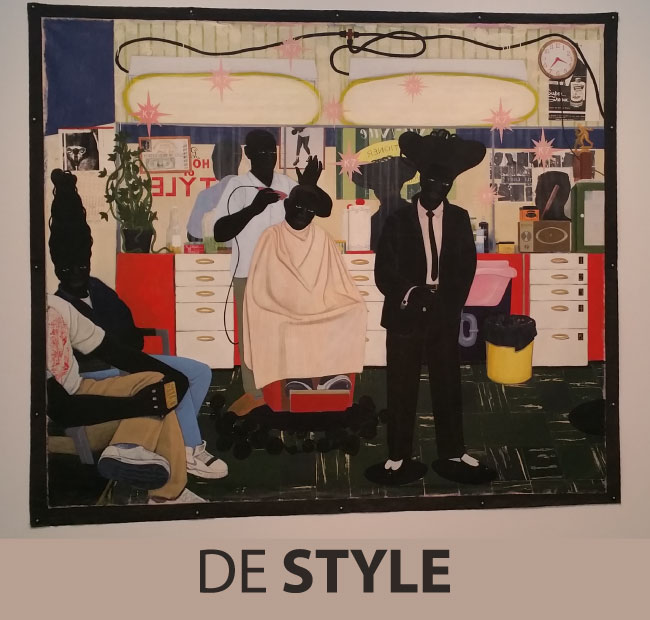
De Style, 1993 Acrylic and collage on unstretched canvas
Marshall has said, “I think it’s important for a black artist to create black figure paintings in the grand tradition. Artworks you encounter in museums by black people are often modest in scale. They don’t immediately call attention to themselves. I started out using history painting as a model because I wanted to claim the right to operate at that level.” The title echoes the name of the barbershop (visible in the mirror), but it also recalls De Stijl, the Dutch modern art movement often associated with Piet Mondrian. In fact, Marshall wove in Mondrian’s signature colors—red, blue, and yellow—as if turning the barbershop scene into one of his predecessor’s geometric abstractions.
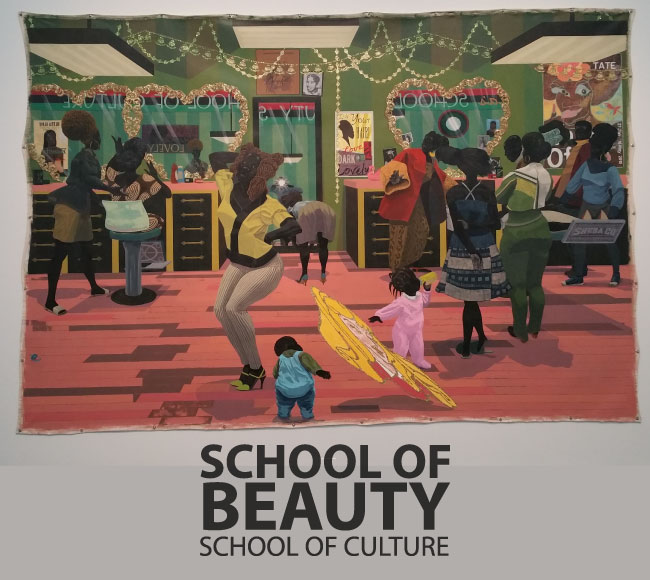
School of Beauty, School of Culture, 2012 Acrylic on unstretched canvas
School of Beauty, School of Culture can be seen as a sequel to Marshall’s regal barbershop scene, De Style, revisiting a theme he painted nineteen years earlier. Like De Style, it translates an everyday locale into a grand history painting. It also demonstrates Marshall’s evolving mastery of the genre. Woven amid the lively arrangement of figures are wide-ranging cultural references: The salon features posters of musician Lauryn Hill and contemporary British artist Chris Ofili. The play of mirrors recalls Diego Velázquez’s oil painting Las Meninas (1656) from the Spanish Golden Age, and the slanted shape at the bottom mimics Northern Renaissance master Hans Holbein’s The Ambassadors (1533), re-imagining that painting’s distorted skull as the blonde head of Disney’s Sleeping Beauty.
THE TAKEAWAY (FOR ME)
Kerry James Marshall has an undeniable talent for producing work that is relevant and relatable. He’s mastered the balance of aggressively addressing political issues through the diplomacy of his canvas. I felt fortunate to view such a diverse collection of his work up close and personal – it gave me the opportunity to truly appreciate the scale of his work and the complexity of his color schemes (especially the darker tones). Emotionally, I left the exhibit feelings validated as a Black person in America, as a Woman of the African Diaspora, and as an Artist.
FOLLOW ME

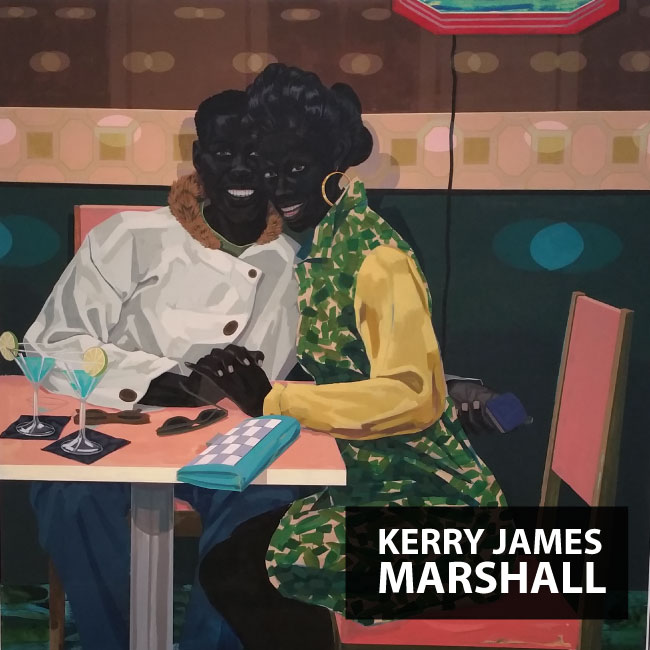
 Multi-faceted Designer, Creative Director & Founder of SCOTCHBONNET! Accessories
Multi-faceted Designer, Creative Director & Founder of SCOTCHBONNET! Accessories